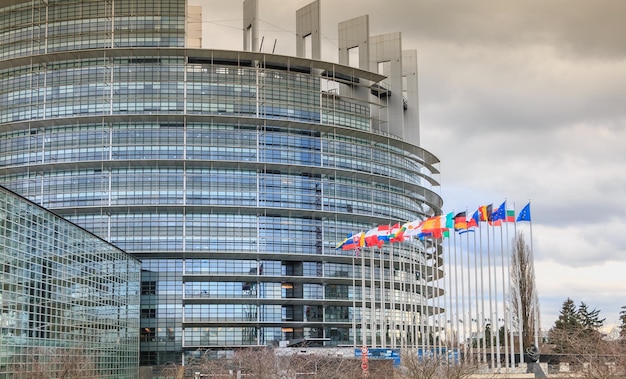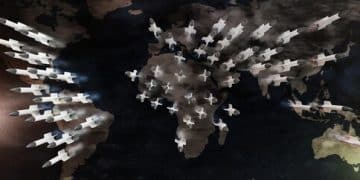The Future of NATO: US Funding Role Under Scrutiny

The future of NATO, particularly concerning the United States’ role as its primary funding source, faces increasing scrutiny amidst evolving geopolitical landscapes and calls for greater burden-sharing from member states. This dynamic challenges the traditional alliance structure and necessitates reevaluation from all parties involved.
The geopolitical landscape is constantly shifting, and with it, the critical alliances that have defined global security for decades. Among these, the North Atlantic Treaty Organization (NATO) stands as a cornerstone of collective defense, but its future, specifically regarding whether the United States will continue to be the primary funding source, is a question of increasing urgency. This inquiry extends beyond mere budgetary concerns; it probes the very essence of transatlantic solidarity, burden-sharing, and the strategic direction of an alliance facing new and complex threats.
the evolving landscape of global security
The world in which NATO was founded has dramatically transformed. From the Cold War’s bipolarity to a multipolar environment marked by resurgent state actors, transnational terrorism, and cyber warfare, the nature of threats has diversified. This evolution fundamentally alters the demands placed on collective security organizations and, consequently, the financial contributions required to address them effectively.
The post-Cold War era saw a reduction in defense spending across many NATO member states, often justified by the perceived absence of an existential threat. However, recent events, particularly Russia’s actions in Ukraine, have served as a stark reminder of the enduring need for robust defense capabilities and a united front. This has reignited debates about defense investment, raising questions about whether current funding levels are adequate for the challenges ahead, and who bears the brunt of this financial responsibility.
shifting defense priorities
As the nature of warfare changes, so too must defense priorities. Traditional military hardware remains critical, but there is an increasing emphasis on areas like cybersecurity, artificial intelligence, space capabilities, and resilient supply chains. These new domains often require significant investment in research, development, and specialized personnel. The disparate capabilities and financial capacities of member states mean that coordinated investment and burden-sharing become even more crucial to ensure a cohesive and effective collective defense.
- Technological integration across military branches remains a key focus.
- Enhanced cybersecurity measures are vital to protect critical infrastructure.
- Investments in resilient logistics and supply lines are becoming paramount.
Moreover, the concept of security itself has broadened. It now encompasses not just military defense but also resilience against hybrid threats, disinformation campaigns, and economic coercion. Addressing these multifaceted challenges requires a comprehensive approach that extends beyond traditional defense budgets, potentially incorporating elements of economic policy, diplomatic initiatives, and technological cooperation. This expanded definition of security further complicates the discussion around funding and equitable contributions.
the united states’ historical role and fiscal pressures
Since its inception, the United States has undeniably been NATO’s largest and most significant financial contributor. Its vast military industrial complex, technological superiority, and substantial defense budget have provided a security umbrella that has arguably allowed many European allies to reduce their own defense spending over the decades. This historical imbalance in burden-sharing has been a recurring point of contention, particularly in recent years.
The rationale for this disproportionate contribution stemmed from the Cold War context, where the US saw a strong and secure Europe as vital to its own strategic interests. However, as Europe’s economic prosperity grew and the immediate Soviet threat receded, calls from Washington for European allies to assume a greater share of the common defense burden became louder. These calls are not new, but they have gained significant traction, driven by domestic fiscal pressures and evolving foreign policy doctrines within the United States.
domestic considerations and foreign policy shifts
In the US, debates about military spending are often intertwined with domestic priorities. Funding for social programs, infrastructure, and healthcare competes with the defense budget. Against this backdrop, the argument that European allies, many with robust economies, should contribute more to their own defense resonates with a segment of the American populace and political leadership. This perspective suggests that resources currently allocated to NATO by the US could be better utilized at home, or shifted to other geopolitical theaters deemed more critical.

Furthermore, there’s a growing sentiment in some US political circles that past foreign policy commitments, including NATO, have overstretched American resources and diverted attention from domestic issues. This inclination towards a more “America First” approach and a reevaluation of global commitments has put renewed pressure on the financial structure of alliances like NATO. The question is not necessarily about abandoning NATO, but rather about renegotiating the terms of engagement and the distribution of financial and military responsibilities.
These fiscal and political considerations within the United States are not transient; they represent a deeper, more fundamental reassessment of America’s global role. Any significant shift in US funding for NATO would have profound implications, compelling European allies to drastically increase their own defense spending or seek alternative security arrangements, potentially altering the strategic balance of power in Europe and beyond.
allies’ responses and burden-sharing initiatives
The consistent pressure from the United States to increase defense spending among NATO allies has not gone unheeded. While progress has been varied across member states, there has been a noticeable trend towards increasing defense budgets, particularly since 2014 when Russia’s annexation of Crimea served as a wake-up call to many European capitals.
NATO’s long-standing guideline is for member states to spend at least 2% of their Gross Domestic Product (GDP) on defense, with 20% of that expenditure going towards major equipment and research and development. While many allies initially lagged far behind this target, recent years have shown an acceleration in reaching or exceeding this benchmark. This increase reflects a growing recognition of shared responsibility, driven both by US pressure and a renewed awareness of regional threats.
challenges and progress towards 2% GDP target
Despite the positive trend, significant disparities persist. Some larger European economies, while increasing their defense spending in absolute terms, still struggle to meet the 2% GDP target, citing various domestic economic and political constraints. These include competing social welfare demands, fiscal austerity measures, and public reluctance to support higher military expenditures. For smaller economies, reaching the 2% threshold may represent a disproportionately large financial commitment.
However, the commitment to the 2% target has been reaffirmed by allied leaders, and progress, while slow for some, is undeniable. Many countries have published detailed plans outlining their trajectory to reach the target, demonstrating a more strategic approach to defense investment. This shift is critical, as it signals a collective understanding that security cannot be taken for granted and requires tangible resource commitments from all members.
- Germany recently announced a significant increase in its defense budget and established a special fund for military modernization.
- Poland has consistently been one of the top spenders relative to its GDP, often exceeding the 2% target.
- The Baltic states, on the frontline with Russia, have also prioritized defense spending.
Beyond direct financial contributions, burden-sharing also encompasses contributions to NATO missions, military exercises, and the provision of expertise and specialized capabilities. Many European nations contribute significantly to these non-financial aspects, deploying troops to multinational battlegroups, participating in cyber defense initiatives, and sharing intelligence. A holistic view of burden-sharing must account for these diverse contributions, recognizing that security is a multi-faceted endeavor that extends beyond direct financial outlays.
alternative funding models and future propositions
Given the persistent debate over the US’s disproportionate funding role, exploring alternative funding models for NATO has become a pertinent discussion. While a drastic overhaul of the current financing system is unlikely, incremental changes and innovative propositions are on the table to ensure greater equity and sustainability.
One primary proposition involves a more rigid enforcement of the 2% GDP defense spending guideline, perhaps with clearer mechanisms for accountability or incentives for compliance. This could involve linking certain NATO benefits or operational roles to a country’s financial commitment, though such measures would likely be contentious and difficult to implement across a diverse alliance.
innovative approaches to resource allocation
Other ideas include exploring direct contributions to a common NATO fund, potentially based on a formula tied to economic output, population, or even a country’s perceived threat exposure. While NATO does have common-funded budgets for specific military and civilian programs, these are relatively small compared to the national defense budgets. Expanding this common fund could centralize certain administrative and operational costs, reducing the reliance on individual nations for specific projects.
Another approach could involve greater specialization among member states, where each country focuses on developing specific military capabilities that benefit the entire alliance. For example, one nation might excel in air defense, another in naval operations, and yet another in cyber warfare. This division of labor, supported by targeted investment from each nation, could create a more efficient and interconnected defense network, optimizing resource allocation across the alliance. This model would necessitate robust coordination and trust among members, ensuring that collective defense capabilities are not compromised by over-specialization in critical areas.
Furthermore, the alliance could explore private sector partnerships for innovation in defense technology, leveraging the expertise and resources of tech companies and defense contractors. This could accelerate the development of cutting-edge capabilities while potentially diffusing the financial burden on national treasuries. Such partnerships would, however, require careful oversight to ensure security protocols and strategic alignment with NATO’s objectives.
geopolitical implications of shifting funding dynamics
Changes in NATO’s funding structure, particularly any reduction in the US’s primary financial role, would inevitably have significant geopolitical implications. A more equitable distribution of defense spending among allies could lead to a stronger, more resilient alliance, less susceptible to the ebb and flow of any single member’s domestic politics or strategic priorities. However, it also carries risks, including potential divisions if the burden-sharing process is not managed sensitively.
A reduced US financial footprint could compel European nations to not only increase their defense budgets but also deepen their defense cooperation, leading to greater European strategic autonomy. While this has been a long-standing goal for some European leaders, achieved independently of US pressure, a shift in NATO funding could accelerate this process, potentially creating a more formidable European defense pillar within the alliance or even an independent security architecture. This would alter the balance of power within NATO and could redefine transatlantic relations.
impact on global power dynamics
Externally, a visible shift in NATO’s funding dynamics could be interpreted by adversaries as either a sign of weakening resolve or as an opportunity to test the alliance’s cohesion. On the other hand, a more self-reliant European defense posture, underpinned by increased investment, could send a strong signal of unity and strength, deterring potential aggressors. The perception of NATO’s unity and capability is as important as the reality, particularly in an era of information warfare and strategic competition.

The broader implications extend to other global alliances where the US plays a significant role, such as those in the Indo-Pacific. If the US successfully encourages greater burden-sharing within NATO, it might seek to replicate this model elsewhere, potentially reshaping the architecture of global security alliances. This could lead to a more distributed and diversified security framework, where multiple actors contribute more equally to collective defense and stability.
Ultimately, the discussion around NATO’s funding is not just about money; it’s about the future of transatlantic security, the distribution of power and responsibility within the alliance, and its effectiveness as a deterrent force in a complex global environment. The outcome of these debates will shape not only NATO’s trajectory but also the broader landscape of international relations for decades to come.
the road ahead for nato: cooperation and evolution
The future of NATO hinges on its ability to adapt to changing geopolitical realities and to address the critical question of burden-sharing. While the United States has historically been and remains its most significant contributor, the call for other member states to step up and assume a greater financial and operational responsibility is a consistent and increasingly prominent theme. This is not merely about fiscal equity but about enhancing the collective resilience and credibility of the alliance.
Achieving a more balanced funding model requires a sustained commitment from all allies, coupled with flexible approaches that recognize the differing economic capacities and strategic priorities of each nation. It demands continued dialogue, transparency, and a shared understanding of the evolving threat landscape. The goal is not to diminish the US commitment, but to ensure that NATO operates as a truly collective defense organization, where all members contribute proportionally to their means and capabilities.
forging a stronger, more equitable alliance
The path forward for NATO involves reinforcing its core principles of collective defense while simultaneously evolving its operational frameworks and funding mechanisms. This will likely include a continuation of efforts to meet the 2% GDP defense spending target, potentially alongside discussions on a more centralized common funding for specific alliance-wide initiatives. Emphasizing smart defense, where nations specialize and pool resources in key areas, could also lead to greater efficiency and effectiveness.
- Continued political will is essential for consistent defense investment across all members.
- Strategic communication is vital to explain the necessity of defense spending to the public.
- Enhancing interoperability and standardization remains crucial for seamless operations.
Ultimately, NATO’s strength lies in its unity and shared values. While financial contributions are a measurable aspect of commitment, the intangible benefits of diplomatic coordination, intelligence sharing, and mutual trust are equally vital. The alliance’s future viability, therefore, depends on its ability to navigate financial complexities while strengthening the bonds of cooperation and solidarity that have served as its bedrock for over seven decades. The question of US funding will continue to be a central tenet of this ongoing evolution, shaping the alliance into a more robust and truly collective defense mechanism for the 21st century.
| Key Aspect | Brief Description |
|---|---|
| 🌍 Shifting Threats | Global security landscape now includes cyber, hybrid, and state threats, necessitating diverse defense investments. |
| 💰 US Funding Role | Historically primary, but domestic pressures and calls for burden-sharing are challenging this dominance. |
| 📈 Allies’ Contributions | Many European nations are increasing defense spending towards the 2% GDP target, signaling greater commitment. |
| 🤝 Future Models | Discussions include stricter 2% enforcement, common funds, and specialized defense roles among members. |
Frequently Asked Questions about NATO Funding
The US has historically been the largest contributor due to its vast economic and military capabilities, a legacy of its Cold War role in securing Western Europe. This significant investment reflected a strategic interest in containing Soviet expansion and maintaining stability on the continent.
It’s a guideline for NATO members to spend at least 2% of their Gross Domestic Product (GDP) on defense. This target was agreed upon in 2006 to ensure allies maintain robust military capabilities and share the alliance’s burden more equitably.
Yes, many NATO allies, especially European members, have significantly increased their defense spending since 2014. This push is in response to geopolitical shifts, heightened security concerns in Europe, and consistent pressure from the United States for greater burden-sharing.
A sudden, drastic reduction could create instability initially. However, if managed through increased contributions from other allies, it could lead to a more balanced and collectively stronger alliance. The key is how any shift is negotiated and implemented by member states.
Proposals include a stricter adherence to the 2% GDP target, expanding common funding for alliance-wide programs, and encouraging greater specialization among members to optimize resource allocation. The goal is to distribute financial responsibility more evenly.
Conclusion
The question of whether the United States will continue to be NATO’s primary funding source is a complex one, deeply intertwined with evolving global security challenges, domestic priorities in the US, and the collective commitment of all alliance members. While the desire for a more equitable burden-sharing is clear and legitimate, the path to achieving it requires nuanced diplomatic effort and sustained political will from all parties. NATO’s enduring relevance in a volatile world depends not just on its military might, but on its capacity for adaptation, collective responsibility, and the unwavering solidarity of its members. The ongoing dialogue about funding is therefore not a sign of weakness, but an essential part of its necessary evolution to meet the demands of the 21st century.





